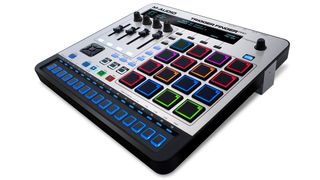NAMM 2014: Whenever the subject of 'best MIDI pad controllers' comes up, one product that always enters the discussion is M-Audio's ageing Trigger Finger. Released in 2005, this has been used by countless producers, and now, finally, there's a successor: the Trigger Finger Pro.
As with the original, there are 16 velocity-sensitive pads, but this time they're illuminated, and accompanied by many more controls. In fact, there are 48 assignable controls, with four faders, four knobs and four buttons being able to switch between four banks each.
Other feature highlights include an onboard step sequencer, a hi-res screen, and instant mapping to popular DAWs. A selection of VST instruments and plenty of sample content comes in the box, too.
More in the press release below. The Trigger Finger Pro will ship in the Spring and should cost $399.

M-Audio Trigger Finger Pro press release
M-Audio (www.m-audio.com), industry-leading manufacturer of award-winning computer interface and studio integration solutions, announces the debut of Trigger Finger Pro, an advanced performance pad controller with onboard sequencing and software integration.
Trigger Finger Pro is a fully encompassed performance instrument and software control station in the form of a portable, 16-pad (4x4 configured) instrument with onboard sequencing. Nearly a decade ago, M-Audio revolutionized the industry by introducing the first performance pad controller and effectively set the stage for the MIDI controller market with the Trigger Finger. The Trigger Finger Pro draws from its predecessor's performance pad roots but features an entirely new hardware design, user experience, and creative functionality to serve both the live performer as well as the music producer. It's modern design features 16 ultra-responsive RGB illuminated pads, 16 backlit step sequencer key controls, a road-ready chassis with brushed aluminum faceplate, and a high resolution screen.
The all-new Arsenal software integrates with popular DAWs, hosts VSTs and includes automatic mapping, providing seamless integration between the hardware and software. Along with AIR Drums and Hybrid 3 plug-ins, Trigger Finger Pro includes 8 GB of ready-to-play sounds, loops, one-shots with exclusive content from Black Anomaly, Prime Loops, Toolroom Records, and more.
Highlights
- 16 Ultra-Responsive Pads - velocity sensitive, illuminated pads with RGB feedback
- Onboard Step Sequencer - accompanied by 16 backlit keys, and high-res screen
- Extensive Expression Controls - 48 assignable controls are offered between 4 faders, 4 knobs, and 4 buttons with 4 banks each, and includes pitch bend, modulation and more
- Arsenal Software - allows for instant DAW/VST integration with full tactile control parameters; or operates as a standalone program with powerful presets & VI's
- AIR Drums and Hybrid 3 - includes two dynamic VST instrument programs, a drum sample player/editor compatible with REX files and a high definition analog synth suite
- Built-in Instruments - 8 GB of sounds, one-shots, loops, and exclusive content
- Customizable Controls - backlit controls instantly map to popular DAWs on the market
- Road Ready Chassis - brushed aluminum faceplate with detachable 3-position stand
"We're excited with the Trigger Finger Pro because it offers true hands-on control for today's multi-talented musicians who require software integration as part of their live performances - and we're equally thrilled with its place in the studio environment providing seamless DAW integration," said M-Audio Product Manager JC Sutherland. "The addition of the new onboard M-Audio Arsenal software makes for a powerful package onstage or in the studio."
Trigger Finger Pro will be available Spring 2014, distributed worldwide with a $399 USD street.

